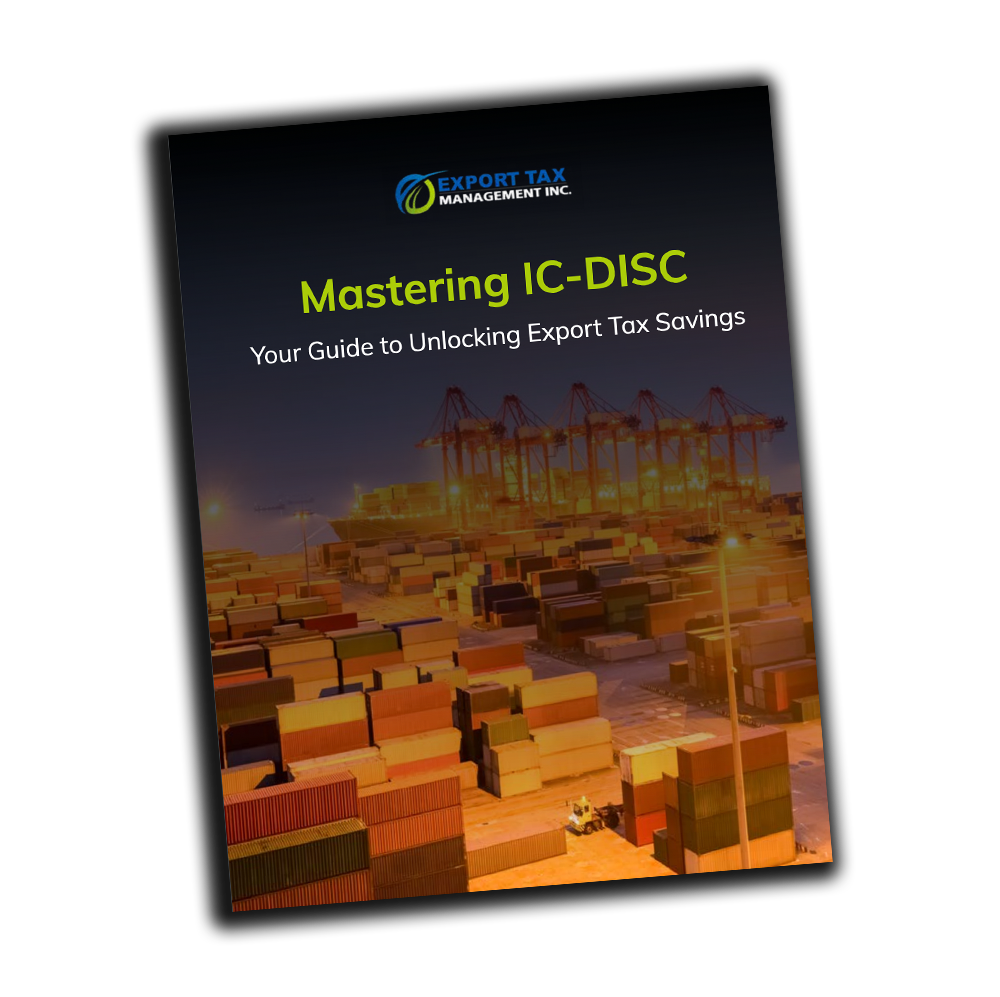Export Promotion Expenses and the IC-DISC – Statutory, Regulatory, and Judicial Analysis for Commission DISCs
The Interest Charge Domestic International Sales Corporation (IC-DISC) regime remains a powerful tool for U.S. exporters, offering significant tax benefits by allowing a portion of export income to be taxed at favorable rates.
A critical component of the IC-DISC calculation is the treatment of “export promotion expenses,” which can increase the amount of income allocated to the DISC under the gross receipts and combined taxable income methods. However, the proper treatment of these expenses, especially in the context of a commission DISC, has been a source of persistent confusion and error among practitioners.
This article provides a detailed analysis of the statutory and regulatory framework, highlights common pitfalls, and offers best practices for compliance.
Table of Contents
- Statutory and Regulatory Framework
- The Commission DISC and Export Promotion Expenses
- Judicial Guidance
- Best Practices for Compliance
- Conclusion
Statutory and Regulatory Framework
Statutory Provisions: IRC

Section 994 of the Internal Revenue Code governs the intercompany pricing rules for transactions between a DISC and related suppliers. For purposes of determining the DISC’s taxable income, provides three alternative methods for setting the transfer price or commission:
- 4% Gross Receipts Method: The DISC’s income is limited to 4% of qualified export receipts plus 10% of export promotion expenses attributable to such receipts.
- 50-50 Combined Taxable Income Method: The DISC’s income is limited to 50% of the combined taxable income from the export transaction plus 10% of export promotion expenses.
- Section 482 Method: The DISC’s income is based on the actual sales price, subject to the arm’s length standard of.
Section 994(c) defines “export promotion expenses” as those incurred to advance the distribution or sale of export property for use outside the United States, excluding income taxes. It also includes, in certain cases, 50% of the cost of shipping export property aboard U.S.-owned or U.S.-flagged carriers, provided such shipment is not required by law or regulation.
Regulatory Provisions: Treas. Reg.
Treasury Regulation provides detailed guidance on what constitutes export promotion expenses:
- Purpose: The expense must be incurred by the DISC to advance the sale, lease, or other distribution of export property for foreign use.
- Types of Expenses: Only certain expenses qualify, including ordinary and necessary business expenses (e.g., advertising, salaries, commissions to unrelated parties), depreciation, certain freight, packaging, and design/labeling costs.
- Ineligible Expenses: Interest, bad debts, freight insurance, state and local income/franchise taxes, manufacturing or assembly costs, and most items of cost of goods sold are excluded.
- Freight Expenses: Only one-half of the freight expense for shipping aboard a U.S.-flag carrier qualifies, and only if not required by law or regulation.
- Packaging and Design: Direct and indirect costs of packaging for export and designing/labeling for export markets may qualify, but not if physically integrated with manufacturing.
- Requirement of Incurrence by the DISC: The expense must be incurred or treated as incurred by the DISC, not by a related supplier, except in limited circumstances (e.g., written agreement for independent contractor services for the benefit of the DISC).
- Timing: Expenses incurred before the year of sale are not treated as export promotion expenses until the year of sale or when it is determined that no transaction will result.
The Commission DISC and Export Promotion Expenses
The Commission DISC Structure

A commission DISC does not take title to export property; instead, it acts as a commission agent for the related supplier (the exporter). The exporter pays a commission to the DISC, which is deductible by the exporter and not taxable to the DISC. The DISC’s income is then distributed to its shareholders, typically at qualified dividend rates.
Common Practitioner Error: Misallocation of Export Promotion Expenses
A frequent error is the allocation of the exporter’s own export promotion expenses to the commission DISC for purposes of the 10% add-on under the gross receipts or combined taxable income methods.
Many practitioners mistakenly believe that the DISC can claim a 10% add-on for export promotion expenses incurred by the exporter, even when the DISC itself has not incurred or reimbursed those expenses.
Regulatory Clarification
Treas. Reg. is explicit: for an expense to be an export promotion expense, it must be incurred or treated as incurred by the DISC. This means:
- If the DISC does not directly incur the expense (e.g., by employing sales staff, paying for advertising, or reimbursing the exporter for such costs), it cannot claim the 10% add-on.
- Merely acting as a commission agent does not entitle the DISC to claim the exporter’s expenses as its own.
- Reimbursements to a related party are only export promotion expenses if they are for space actually used by DISC employees or for export property owned by the DISC.
Judicial Guidance: Computervision Corp. v. Commissioner

In Computervision Corp. v. Commissioner, 94 T.C. 11 (1990), the Tax Court addressed the proper allocation of export promotion expenses in the context of a commission DISC. The court held:
- Only expenses actually incurred by the DISC, or for which the DISC is contractually obligated, qualify as export promotion expenses.
- The mere fact that the related supplier incurs export promotion expenses does not permit the DISC to claim the 10% add-on unless the DISC has reimbursed the supplier or otherwise incurred the expense.
- The court rejected the taxpayer’s attempt to allocate the exporter’s expenses to the DISC, emphasizing the need for a real economic outlay by the DISC.
This decision underscores the importance of respecting the separate corporate existence of the DISC and the need for actual incurrence or reimbursement of expenses to claim the export promotion add-on.
Best Practices for Compliance
- Substantiate DISC Expenses: Ensure that the DISC directly incurs export promotion expenses or reimburses the exporter under a written agreement. Maintain documentation of all such expenses and reimbursements.
- Review Contracts: If using independent contractors, ensure that contracts specify the portion of services performed for the DISC and that the DISC is contractually obligated to pay for those services.
- Avoid Automatic Allocations: Do not automatically allocate the exporter’s export promotion expenses to the DISC. Only expenses meeting the regulatory requirements should be included.
- Segregate Functions: If the DISC is a commission DISC, consider whether it should undertake additional activities (e.g., marketing, sales support) and incur related expenses to maximize the allowable 10% add-on.
- Audit Trail: Maintain a clear audit trail showing the DISC’s incurrence or reimbursement of export promotion expenses, including invoices, payment records, and board resolutions authorizing such expenditures.
- Consult Judicial Precedent: Be aware of the Computervision decision and similar cases, and ensure that your approach is consistent with judicial guidance.
If you want to take your international business to the next level, IC-DISC is the answer. Check out our related articles:
- How an IC-DISC Structure Can Lower Federal Taxes on Export Income
- IC-DISC No Loss Rule – What Exporters Must Know
- IC-DISC Tax Strategy for Export Tax Savings – Prepare for 2026
- IC-DISC Rules 2025 – Compliance, Formation, & Tax Savings
- PLRs and Interest of Government not Prejudiced
20+ Years IC-DISC Experience
Unlock Significant Tax Benefits with IC-DISC
Our objectives are simple: to provide you with maximum export tax savings, while delivering unmatched personal attention by our staff of CPAs. Schedule a free consultation today to discuss how Export Tax Management can help you.
Schedule Free ConsultationConclusion
The treatment of export promotion expenses in the context of an IC-DISC, particularly a commission DISC, is governed by a detailed statutory and regulatory framework that requires the DISC to actually incur or reimburse such expenses to claim the 10% add-on. Practitioners must avoid the common error of allocating the exporter’s expenses to the DISC without proper substantiation. Adhering to the requirements of IRC, Treas. Reg., and judicial guidance such as Computervision Corp. v. Commissioner is essential for compliance and to withstand IRS scrutiny.
References:
- IRC § 994
- Treas. Reg. § 1.994-1(f)
- Computervision Corp. v. Commissioner, 94 T.C. 11 (1990)
For further reading and practical examples, see the detailed examples in Treas. Reg. § 1.994-1(g).
If you want to take your international business to the next level, IC-DISC is the answer. Check out our related articles:




